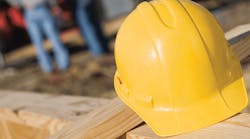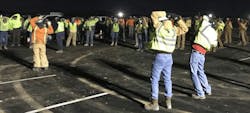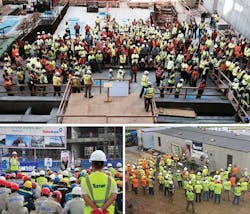When it comes to safety, it’s all about prevention. For Turner Construction Company, an international construction services company, it’s not just about compliance, it’s about something all EHS professionals strive for: continuous improvement on the road to zero injuries and incidents.
The New York-based construction company balances a diverse staff of 5,200 employees who complete 1,500 projects,worth roughly $10 billion, each year in a myriad of industries from healthcare to education, commercial, sports, aviation, pharmaceutical, retail and green building.
“It’s really critical that you have the right subcontractor that is going to be engaged in the process,” says Scott Cole, Northern Ohio business unit safety director at Turner.
The company’s core values of integrity, teamwork and commitment guides its relationship with its 99 percent subcontractor workforce, with the overall mission to:
• Deliver environmentally responsible client services
• Provide employees with an attractive working environment
• Be an active community partner
• Maintain high ethical standards
• Drive continuous improvement.
“What it comes down to are the people in the field watching out and honestly caring for one another,” Cole says.
With a bottom-up movement in place, safety permeates every facet of the company, and each worker has an equal say in what’s safe and what measures need to be put in place to prevent injury. Because of this, Turner boasts a 1.6 percent incident rate.
To achieve this, workers from recent hires to 30-year veterans are engaged, trained and aware of every pre-task and on-the-job safety initiative, and they alert supervisors of any changing conditions that could create additional hazards.
Pre-task Activities
With an aging workforce, preventing musculoskeletal injuries is a must at Turner Construction. The company employs an ergonomically-driven workout routine to make sure workers are warmed up and ready-to-go.
“It’s similar to how you warm up for a game as an athlete,” Cole says.
A quick reference guide the company calls Stretching Principles walks employees step-by-step through a stretch and flex process, first by cautioning workers to “only stretch to your level of comfort.”
Form is emphasized, and each worker moves at their own pace. A set of “stretching principles” guides each worker in an ergonomically-focused workout designed to warm up each muscle throughout the body. Various movements target different muscle groups, specifically:
• Warm-Up: Heats muscles through large-muscle group rhythmic activity, including shoulder shrugs, backstroke and bench-press motions
• Shot Put: Continues warm-up, focuses on reaching and pivoting
• Skyward Reach: Targets lats, forearms, spinal muscles
• Chest: Targets chest, biceps and forearms
• Tricep: Targets triceps and lats
• Shoulder: Targets shoulders and upper back
• Quadricep: Targets front thigh
• Neck: Targets neck and collar muscles
• Forearm: Targets wrists, hands and forearms
• Shoulder release: Targets shoulders and upper back
• Calf: Targets calves and Achilles tendon.
After the workout is completed, a traditional pre-task planning process begins. The project foreman or superintendent talks about the necessary personal protective equipment and tools, mapping out the safety plan on a dry-erase board for workers to study. Hazards are identified as well as control measures.
“Work doesn’t begin until the control measures are explained,” Cole says. “What’s true right this minute could be different five minutes or 10 minutes later.”
Even with a strong safety focus on an everyday basis, these pre-task safety measures also are supplemented with entire days dedicated to training Turner’s entire workforce.
Standing Down
Tracing back more than a decade, Turner organizes and implements a company-wide safety stand-down on all active project sites. More than 40,000 workers to date have participated in the event, which zones in on different areas of safety each year.
During the annual safety stand-downs, Turner suspends work on project sites around the world to deliver a message on an important safety theme.
Past themes have included Coaching and Practicing Critical Safe Behavior, Proper Pre-Task Planning for Safety, and Promoting Personal Health and Well-Being On and Off the Job.
“Our annual Safety Stand-Down is an opportunity to gather and reaffirm our collective commitment to sending every one of those workers home safe every day,” declares Cindy DePrater, Turner’s vice president of Environmental Health & Safety.
Presentations often target most common causes of jobsite incidents – such as slips, trips, and falls – by practicing a number of key safety behaviors deemed critical, according to the company.
These hyper-focused safety stand-downs, along with Turner’s other safety initiatives, have led to a significant drop in incidents, says DePrater.
Company projects in the Southeast region of the United States (Georgia, the Carolinas, Florida, Tennessee and Alabama) have experienced an 86 percent drop in ladder-related incidents, she says.
“The Southeast has dramatically reduced its dollar claims by 99% from a high of $620,000 in 2009 to $1,292 in 2013,” she adds. “More importantly, the same results are being seen throughout our office network; Ohio’s claims, for instance, plummeted from $770,290 in 2011 to $620 in 2013.”
Observe and Report
Turner’s goal is to convey and cultivate a culture of active caring when it comes to safety and caring for one another.
Workers are encouraged to observe their teammates and provide feedback if at-risk or unsafe behaviors are observed. This partnership between co-workers emphasizes the company’s quest to foster respect, care and a commitment to mutual responsibility, according to the Turner website.
Worker engagement extends far beyond the typical training session, and includes measures such as:
Five-Worker Lunch
A five-worker lunch occurs on a monthly basis. Participants randomly are chosen from a pool to enjoy a complimentary meal and have a meaningful discussion about safety or company issues they observe. The lunch works as an open forum, and each suggestion is considered.
Critical Safe Behavior Coaching
A worker’s behavior is observed for 10 minutes, focusing on how they interact with a certain task.
Observation Circle
Upper management or a foreman studies a worker for 15 minutes. The worker is then told how to minimize their movements to make repetitive tasks more efficient and safer.
Overall, Turner’s drive to continuous improvement has created a complex set of safety procedures and initiatives, the ultimate end-game being something all EHS professionals strive to accomplish: making sure every worker goes home safe each day.
“Human life is of the utmost importance in everything to prevent loss of life and limb across state and international boundaries,” Cole says.
______________________
Living Injury Free Every Day
Turner Construction’s drive to create a world-class safety culture extends beyond its safety program and OSHA partnerships. The company’s commitment to a safe workplace is summed up in its trademarked Building L.I.F.E. (Living Injury Free Every Day) motto aligns with Turner’s goal to eliminate all worksite incidents through pre-planning construction activities with safety engagement commencing at project pursuit.
The goal is supported by four guiding principles:
1) Injuries are preventable.
2) Perform a job only if it is safe.
3) Working safely is a condition of employment.
4) Practice and expect safe behavior everywhere, every day.
The company explains what drives these safety fundamentals in detail on its website:
“Turner understands the environmental, social, and economic impact of our activities and that it is our responsibility to conduct our business in a transparent and ethical manner that supports our goals for client service, community involvement, environmental performance, financial strength and employee health, safety and wellbeing. Our core values of integrity, teamwork and commitment guide our activities and we expect the organizations with which we do business to share our commitments.”



